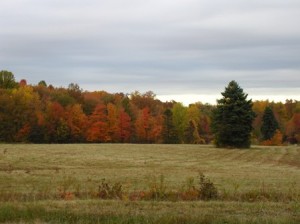We have much more to do and your continued support is needed now more than ever.
CWRU to Experiment with Freshwater Turbine

And create alternatives, they will.
A feasibility study released on May 1, 2009, reveals that Case Western will partner with Cuyahoga County and the City of Cleveland in a pilot project to construct the first offshore wind turbine at a fresh water site.
While other wind turbines have been constructed offshore, this project is unique in that it requires turbine designs to compensate for icing in the lake during winter months, something that does not present problems for turbines onshore or in saline environments.
Associate professor of materials science and engineering, David Mattheisen, explains a possible solution: “The concrete foundation to which the steel monopole is attached (which in turn has the turbine on top of it) has a 55 degree angle taper to it (thus making a cone rather than a cylinder). When the ice impinges on this downward sloping cone, it is pushed down, buckles and breaks. It can then easily move around the foundation.”
The pilot project entails constructing between three and eight turbines in Lake Erie near downtown Cleveland, as well as constructing three affiliated Advanced Research Centers. Depending on which version of the pilot project is chosen, the constructed turbines will provide between 15 and 20 total megawatts of power.
Compared to other installations, these numbers are relatively small. However, the main goals of the project are to raise awareness about wind power in the region and to advance research and technology of wind power, rather than to make profits. Mattheisen says, “The purpose of a pilot project is to demonstrate that it can be done and to reduce the risk to the major investment needed for a commercial wind farm.”
Economics present another challenge. While an offshore wind project is more costly than a similar onshore project, the offshore site has greater wind potential due to fewer obstacles such as trees and buildings to slow the wind and reduced surface friction over water relative to land. The report cautions that this pilot project will come at an expense, yet over time will lead to advances in technology and design that will encourage economic growth in the region and increase the chances of success for future wind initiatives. Proponents of the pilot project hope to receive funding from a power purchase agreement (PPA) with Cleveland Public Power or First Energy as well as from other sources including the ITC through the 2009 Stimulus Act.
In a second project to advance wind power, Case Western hopes to construct a wind turbine to power the university farm by fall of this year. According to Matthiesen, “The farm would like to be completely green.”
In 2008, the university began research to determine how much energy the farm uses on its 400-acre off-campus site, and the average amount of wind available for harnessing. Ana Locci, full-time director at the university farm and adjunct professor in biology, worked closely with emeritus professor for campus planning, Ken Kutina, on the various stages of this project. Together they determined a 50 kilowatt turbine will provide 80 percent of the power needed for six of the 25 buildings on the farm.
The farm is responsible for less than one percent of Case Western’s approximately 1.8 million kWh of energy consumption each year, making the impact of these turbines very small. More important than the numbers, Robson contends, is that Case Western is making progress simply by choosing to install a wind turbine. She states, “It’s more than just offsetting 80 percent of 1 percent of total energy consumption; it’s about having a farm on campus in the first place.” While the energy savings may be slim, “That’s 80 percent of 1 percent more than what we had a year and a half ago,” she says.
This farm project will not earn the university a profit, according to Locci. “Mostly we see it as a teaching tool as well as a way to produce clean electricity which is great for [the] environment and what we do,” Locci says, noting that the project “is just part of the big picture” of sustainability efforts the school has initiated.
According to Locci, the university has already gained a permit from Hunting Valley to construct the turbine and is in the process of visiting sites, looking at turbines, listening to them, and trying to find the best turbine option for their site.
Robson points out that the university has signed onto the University President’s Climate Commitment and designed a climate action plan. While the university has not yet identified specific goals for carbon emissions reductions, she says, available records of 10-years’ worth of energy consumption data puts the school in a good place to begin analyzing consumption and setting goals.
Locci adds that the connection between the various wind research projects the university has involved itself with is “to get people used to seeing turbines and learning about them, listening to them…getting the technology to the community.”




















